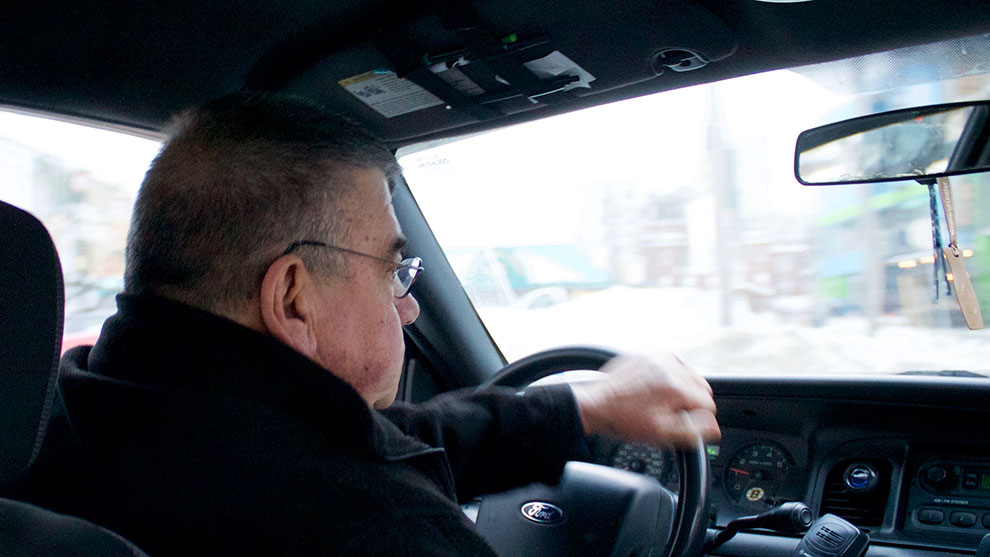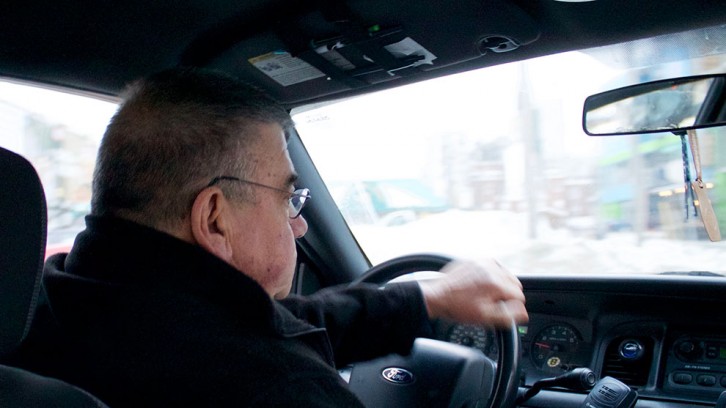City
Winter driving a gamble—especially for cabs
Snowstorms cause Halifax taxis to balance increased business demand against viability.

caption
Charles O’Connell navigates rush hour traffic and snow banks in downtown Halifax.
caption
Charles O’Connell navigates rush hour traffic and snow banks in downtown Halifax.It took two calls for Shannon O’Toole to order a cab to King’s. At 10:30 p.m. on a Friday night, that’s not uncommon.
But after six hours of snowfall, backed up snow removal, and bus delays of almost an hour, O’Toole is lucky.
Winter driving in Halifax can be risky—especially when driving a taxi.
That’s why Charles O’Connell, a veteran among cab drivers in Halifax with 46 years under his belt, doesn’t drive in extreme winter weather.
It’s not for safety reasons; it’s a business decision.
“If you put collision (insurance) on a taxi you’re going to be paying about $5,000 a year. So no, it’s not really worth it,” O’Connell said.
He says most drivers don’t venture out during storms, because if they get into an accident they can be put out of business for weeks.
“Do you put a day’s wages against a month’s wages?” he asks. “Because if somebody slides into you, you’re off the road.”
The taxi business in Halifax is different from that in many major cities in Canada, as every driver is an entrepreneur—even those driving under the roof lights of large companies such as Casino or Yellow Cab. This is because companies can’t own cars or licenses. They can only dispatch.
For drivers, this means the full cost of operation is on them. Licensing, inspections, maintenance, repairs and costly insurance: all come directly out of their own pockets. Most also own their cars to begin with.
But taxi rates stay the same regardless of the weather, or risk.
Boom or bust
Leng Xu also drives a cab under a Casino roof light.
“(During winter storms) it gets busier, but the fares remain the same. The risk goes up,” Xu explained. “You might get stuck somewhere in the snow.”
On a normal weekend, O’Connell estimates close to 200 cabs from all the companies are on the road throughout the municipality. When the weather turns bad, a lot of drivers go home, he says, with the number of cabs dropping by more than half.
That means the remaining cab drivers are a lot busier, but at the customer’s expense. Trips take longer, and with fewer drivers, that 10-minute target goes out the window. After that, the weather causes a snowball effect, and it’s downhill from there.
O’Connell believes some people will tip more in poor weather, but not if they have to wait 45 minutes to get through on the phone.
Cost of doing business

caption
O’Connell next to his cab.Ultimately, the taxi business—like any business—is a risk. Those who succeed tend to have a few common advantages: they own their own licence—a roughly $5,000 a year cost otherwise—and can drive affordable cars. Forty-six years on, O’Connell has both.
In addition to renting a licence, drivers still need to pay dispatch fees, gas and insurance. O’Connell estimates it costs about $35,000 a year to run a cab. The average cab driver’s car is $6,000 to $7,000 and lasts about two years.
“On an average day you probably take in about $200 if you work 12 hours,” he said.
O’Connell is a supervisor for Casino, so he doesn’t pay dispatch fees. To save even more money, he uses disposable cars.
“I pay $1,500 to $2,000 for a car,” O’Connell said. “If this thing gets smacked up, I’ll put another one in. I might be down a couple days, gettin’ the equipment changed over.”

